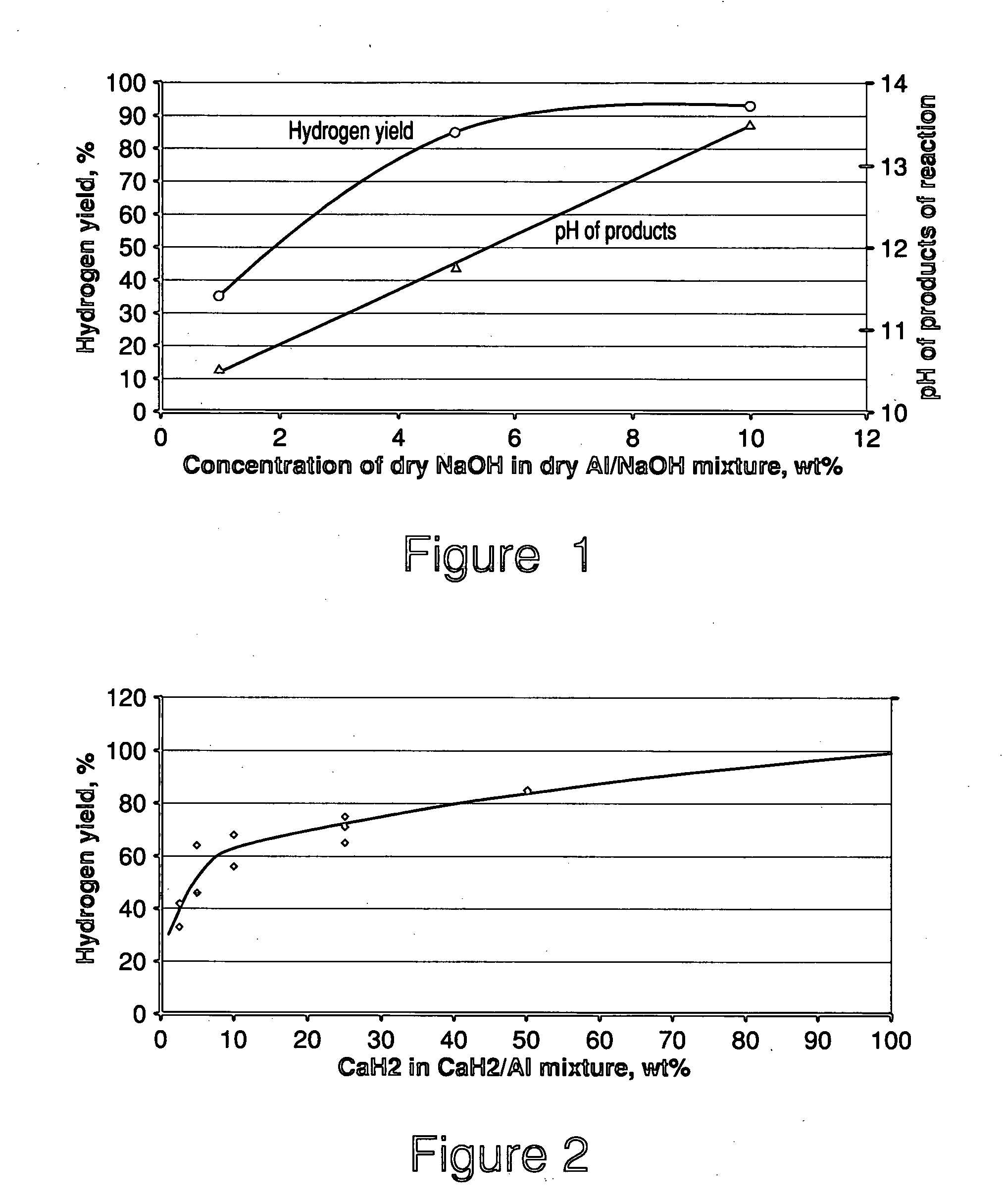Method for generating hydrogen gas
a hydrogen gas and gas technology, applied in the field of hydrogen gas generation, can solve the problems of high exothermicity, large heat, and reaction also being explosiv
- Summary
- Abstract
- Description
- Claims
- Application Information
AI Technical Summary
Benefits of technology
Problems solved by technology
Method used
Image
Examples
example 1
[0047] Aluminum powder, 0.475 g (Acros Organics, 200 mesh, 99% purity), and sodium hydroxide powder, 0.025 g, were mixed together. The mixture was placed into a 50 mL glass reactor, and the contents were stirred using a magnetic stir bar placed inside the reactor. The reactor was heated to maintain a temperature of 60° C.. The hydrogen generation reaction was initiated by injecting 4 g of water into the reactor using a syringe. The hydrogen generated from the reaction flowed through a stainless steel knockout drum placed in an ice water bath to remove water vapor. The flow rate of the hydrogen was measured using a mass flow meter.
[0048] The total amount of hydrogen generated was 608 std cm3. This amount of hydrogen represents a yield of 85% (amount of hydrogen generated divided by theoretical amount of hydrogen generated from complete reaction). The pH in the reactor at the end of the experiments was 11.75.
[0049] The behavior of systems catalyzed by different concentrations of NaO...
example 2
[0050] Mixtures of aluminum powder (Acros Organics, 200 mesh, 99% purity) and calcium hydride were prepared. The amount of CaH2 in the CaH2 / Al mixtures ranged from 2 percent by weight to 50 percent by weight. The mixtures were placed individually into a 50 mL glass reactor, and the contents were stirred by using a magnetic stir bar placed inside the reactor. Hydrogen generation reaction was initiated by injecting water into the reactor. The hydrogen generated from the reaction flowed through a stainless steel knockout drum placed in an ice water bath to remove water vapor.
[0051]FIG. 2 shows the hydrogen yield as a function of percent by weight of CaH2 in the reactant mixture. For a 50% CaH2 / 50% Al powder mixture, the yield was high (85%). As the fraction of CaH2 decreases, the yield also decreases. However, even when 5% CaH2 was used, the yield was about 50%.
example 3
[0052] Aluminum powder, 0.45 g (Acros Organics, 200 mesh, 99% purity), sodium hydroxide powder, 0.025 g, and calcium hydride, 0.025 g, were mixed together. The mixture was placed into a 50 mL glass reactor, and the contents were stirred by using a magnetic stir bar placed inside the reactor. Hydrogen generation reaction was initiated by injecting water into the reactor. The hydrogen generated from the reaction flowed through a stainless steel knockout drum placed in an ice water bath to remove water vapor.
[0053] The total amount of hydrogen generated was 614 std cm3. This amount of hydrogen represents a yield of 86%.
PUM
| Property | Measurement | Unit |
|---|---|---|
| temperature | aaaaa | aaaaa |
| temperature | aaaaa | aaaaa |
| particle diameter | aaaaa | aaaaa |
Abstract
Description
Claims
Application Information
 Login to View More
Login to View More - R&D
- Intellectual Property
- Life Sciences
- Materials
- Tech Scout
- Unparalleled Data Quality
- Higher Quality Content
- 60% Fewer Hallucinations
Browse by: Latest US Patents, China's latest patents, Technical Efficacy Thesaurus, Application Domain, Technology Topic, Popular Technical Reports.
© 2025 PatSnap. All rights reserved.Legal|Privacy policy|Modern Slavery Act Transparency Statement|Sitemap|About US| Contact US: help@patsnap.com

